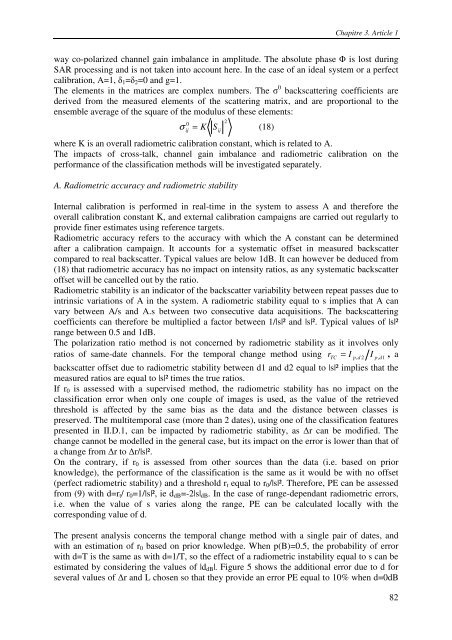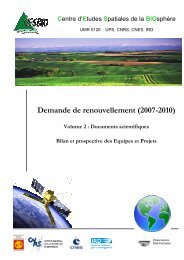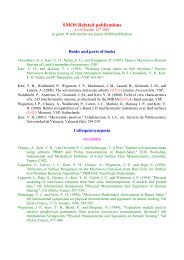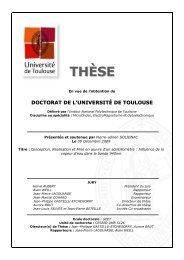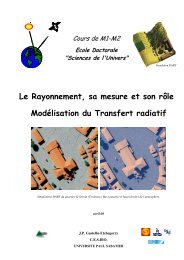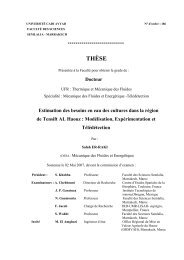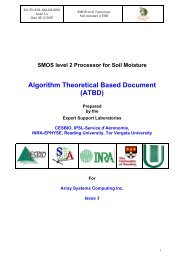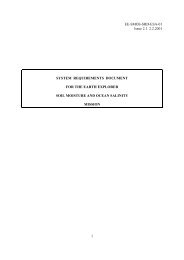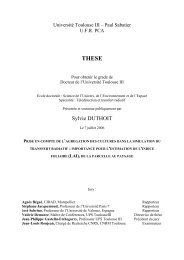THÃS EE - CESBIO - Université Toulouse III - Paul Sabatier
THÃS EE - CESBIO - Université Toulouse III - Paul Sabatier
THÃS EE - CESBIO - Université Toulouse III - Paul Sabatier
Create successful ePaper yourself
Turn your PDF publications into a flip-book with our unique Google optimized e-Paper software.
Chapitre 3. Article 1way co-polarized channel gain imbalance in amplitude. The absolute phase Φ is lost duringSAR processing and is not taken into account here. In the case of an ideal system or a perfectcalibration, A=1, δ 1 =δ 2 =0 and g=1.The elements in the matrices are complex numbers. The σ 0 backscattering coefficients arederived from the measured elements of the scattering matrix, and are proportional to theensemble average of the square of the modulus of these elements:0ijS ij2σ = K(18)where K is an overall radiometric calibration constant, which is related to A.The impacts of cross-talk, channel gain imbalance and radiometric calibration on theperformance of the classification methods will be investigated separately.A. Radiometric accuracy and radiometric stabilityInternal calibration is performed in real-time in the system to assess A and therefore theoverall calibration constant K, and external calibration campaigns are carried out regularly toprovide finer estimates using reference targets.Radiometric accuracy refers to the accuracy with which the A constant can be determinedafter a calibration campaign. It accounts for a systematic offset in measured backscattercompared to real backscatter. Typical values are below 1dB. It can however be deduced from(18) that radiometric accuracy has no impact on intensity ratios, as any systematic backscatteroffset will be cancelled out by the ratio.Radiometric stability is an indicator of the backscatter variability between repeat passes due tointrinsic variations of A in the system. A radiometric stability equal to s implies that A canvary between A/s and A.s between two consecutive data acquisitions. The backscatteringcoefficients can therefore be multiplied a factor between 1/|s|² and |s|². Typical values of |s|²range between 0.5 and 1dB.The polarization ratio method is not concerned by radiometric stability as it involves onlyratios of same-date channels. For the temporal change method using rTC= Ip, d 2Ip,d1, abackscatter offset due to radiometric stability between d1 and d2 equal to |s|² implies that themeasured ratios are equal to |s|² times the true ratios.If r 0 is assessed with a supervised method, the radiometric stability has no impact on theclassification error when only one couple of images is used, as the value of the retrievedthreshold is affected by the same bias as the data and the distance between classes ispreserved. The multitemporal case (more than 2 dates), using one of the classification featurespresented in II.D.1, can be impacted by radiometric stability, as ∆r can be modified. Thechange cannot be modelled in the general case, but its impact on the error is lower than that ofa change from ∆r to ∆r/|s|².On the contrary, if r 0 is assessed from other sources than the data (i.e. based on priorknowledge), the performance of the classification is the same as it would be with no offset(perfect radiometric stability) and a threshold r t equal to r 0 /|s|². Therefore, PE can be assessedfrom (9) with d=r t / r 0 =1/|s|², ie d dB =-2|s| dB . In the case of range-dependant radiometric errors,i.e. when the value of s varies along the range, PE can be calculated locally with thecorresponding value of d.The present analysis concerns the temporal change method with a single pair of dates, andwith an estimation of r 0 based on prior knowledge. When p(B)=0.5, the probability of errorwith d=T is the same as with d=1/T, so the effect of a radiometric instability equal to s can beestimated by considering the values of |d dB |. Figure 5 shows the additional error due to d forseveral values of ∆r and L chosen so that they provide an error PE equal to 10% when d=0dB82


